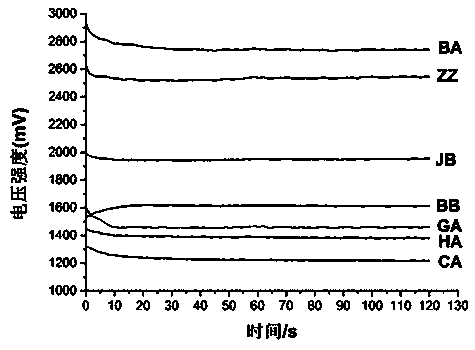Method for qualitatively and quantitatively detecting tea quality based on multi-sensor fingerprint
A fingerprint and quantitative detection technology, applied in the direction of instruments, measuring devices, scientific instruments, etc., can solve the problems of complex determination process of chemical components, achieve high practical application value, simple operation, and objective and reliable analysis results
- Summary
- Abstract
- Description
- Claims
- Application Information
AI Technical Summary
Problems solved by technology
Method used
Image
Examples
Embodiment
[0032] In order to more clearly illustrate the technical problems, technical solutions and advantages to be solved by the present invention, a detailed description will be given below in conjunction with specific embodiments.
[0033] 1. Collect 6 samples of Longjing tea with different quality grades as the experimental objects. These tea samples are picked from Shifeng Mountain in Hangzhou. For each tea sample, take 5g of tea leaves and infuse them for 5 minutes according to the tea water ratio of 1:50, then filter, cool, and use for the detection of electronic nose, electronic tongue and electronic eyes, and make 32 tea leaves for each grade of Longjing tea sample Sample duplicates. For electronic nose detection, take 200mL of tea soup and put it into a 500mL beaker, seal it with plastic wrap and let it stand for 60min, so that the sample gas reaches saturation in the headspace of the container, and then use the electronic nose to extract the sample headspace gas in the cont...
PUM
 Login to View More
Login to View More Abstract
Description
Claims
Application Information
 Login to View More
Login to View More - R&D
- Intellectual Property
- Life Sciences
- Materials
- Tech Scout
- Unparalleled Data Quality
- Higher Quality Content
- 60% Fewer Hallucinations
Browse by: Latest US Patents, China's latest patents, Technical Efficacy Thesaurus, Application Domain, Technology Topic, Popular Technical Reports.
© 2025 PatSnap. All rights reserved.Legal|Privacy policy|Modern Slavery Act Transparency Statement|Sitemap|About US| Contact US: help@patsnap.com



